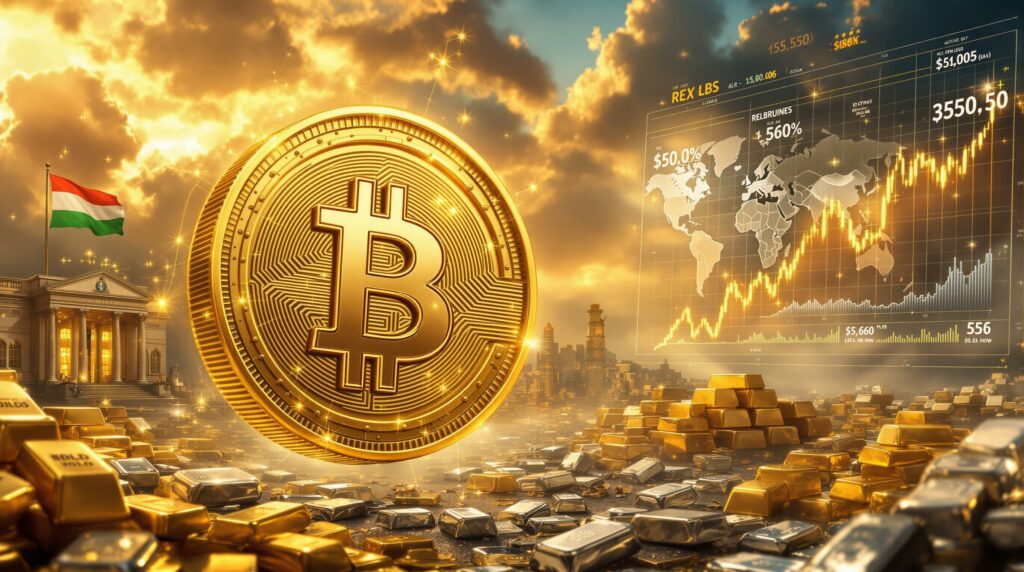The Evolution of Gold and Silver in Global Trade Settlement
In today's rapidly shifting economic landscape, precious metals are making a remarkable comeback in international finance. Once the backbone of monetary systems worldwide, gold and silver are now re-emerging as trusted assets for gold and silver as trade settlement between nations. This renaissance comes at a time when traditional fiat currencies face unprecedented challenges, prompting countries to seek more stable alternatives for conducting global commerce.
Economic Indicators Revealing Monetary Weakness
Recent U.S. employment data has raised significant concerns among economic analysts. What initially appeared as strong job growth has undergone substantial downward revisions, revealing a much weaker labor market than officially reported. These revisions expose a troubling pattern where job creation figures were substantially overstated, calling into question the reliability of economic data driving monetary policy decisions.
The disconnect between official inflation metrics and real-world costs continues to widen. While government statistics might suggest modest inflation rates around 2-3%, everyday consumers experience a drastically different reality. Housing, food, education, and healthcare costs have all increased at rates far exceeding official Consumer Price Index (CPI) figures.
"The changes in CPI calculation methodology over the past few decades have systematically understated inflation, masking the true erosion of purchasing power experienced by average citizens."
This discrepancy stems partly from methodological changes to CPI calculations implemented since the 1980s. These modifications, including substitution effects, hedonics, and geometric weighting, have fundamentally altered how inflation is measured. Alternative calculations using pre-1980s methodologies suggest actual inflation rates could be significantly higher than official figures.
Shadow statistics compiled by independent economists paint a more concerning picture. When using consistent measurement methodologies over time, the loss of purchasing power appears far more dramatic than officially acknowledged, helping explain why many households feel increasingly financially strained despite supposedly modest inflation.
Geopolitical Shifts Driving Precious Metals Demand
The BRICS nations (Brazil, Russia, India, China, South Africa) have been strategically positioning themselves to reduce dependence on the U.S. dollar. This alliance, which has expanded to include several Middle Eastern and African nations, now represents a formidable economic bloc actively seeking alternatives to dollar-denominated trade.
India's energy policy decisions provide a compelling example of this shift. The country has maintained trade relationships with Russia despite Western sanctions, arranging alternative payment mechanisms that bypass traditional dollar-based systems. This pragmatic approach prioritizes energy security and economic sovereignty over geopolitical alignment.
Emerging trade settlement mechanisms operating outside the dollar system are gaining traction. These platforms enable direct currency exchanges or commodity-backed transactions without converting to dollars first, reducing transaction costs and minimizing exposure to U.S. monetary policy decisions.
- Bilateral currency swap arrangements between central banks
- Commodity-based direct exchange systems
- Regional payment networks independent of SWIFT
- Digital currency experimentation for cross-border settlements
Safe haven demand for precious metals has reached record levels amid this global uncertainty. Central banks worldwide purchased more gold in 2022-2023 than in any comparable period in recent history, signaling a collective hedge against currency instability.
How Gold Is Being Integrated Into International Trade Settlement
The integration of gold into modern trade settlement systems represents a fascinating blend of ancient monetary principles with cutting-edge technology. This hybrid approach offers the stability of gold with the efficiency of digital transactions.
The MBridge System and Blockchain Implementation
The Bank for International Settlements has been developing the Multiple CBDC Bridge (mBridge) project, which creates a platform for direct transactions between different central bank digital currencies. While not exclusively gold-backed, this system establishes the infrastructure through which commodity-backed trading could function efficiently across borders.
Blockchain technology enables these alternative settlement mechanisms by providing immutable transaction records without requiring trusted intermediaries. This technological foundation allows for:
- Transparent verification of gold reserves backing transactions
- Real-time settlement without traditional clearing delays
- Fractional gold unit transfers impossible with physical movement
- Reduced counterparty risk through smart contract execution
When compared to the traditional SWIFT payment infrastructure, these emerging systems offer significant advantages in settlement speed, transparency, and resilience against external pressure. While SWIFT typically requires multiple intermediaries and can take days for final settlement, blockchain-based systems can complete transactions within minutes.
The current operational status of gold-based trade settlement systems varies by region and partnership. Several bilateral arrangements between BRICS nations and their trading partners have moved beyond the pilot stage to handle real commercial transactions, though volumes remain modest compared to dollar-dominated trade.
Central Bank Gold Acquisition Strategies
Global central bank purchasing patterns reveal a coordinated strategic shift toward gold accumulation. This trend represents more than simple diversification—it suggests preparation for a monetary system where gold plays a more formal role in international settlements.
Central banks added approximately 1,136 tonnes of gold to their reserves in 2022, followed by another 800+ tonnes in 2023, according to World Gold Council data. This unprecedented pace of acquisition has been led by emerging economies seeking to reduce dollar dependence.
The strategic rebalancing of national reserve assets follows a clear pattern:
| Region | Gold Acquisition Strategy | Apparent Motivation |
|---|---|---|
| Eastern Nations | Aggressive accumulation | Reducing dollar exposure |
| Western Nations | Maintaining reserves | Preserving monetary options |
| Resource Exporters | Steady increases | Securing trade settlement alternatives |
Industry analysts suggest a potential timeline for major monetary system changes extending over the next 3-5 years, with incremental adoption of gold and silver as trade settlement mechanisms rather than an abrupt reset. This gradual approach allows for system testing while minimizing market disruption.
What Makes Silver a Potentially Superior Investment to Gold?
While gold typically dominates discussions about monetary metals, silver presents a compelling investment case with unique fundamentals that could drive exceptional performance in the coming years.
Silver's Supply-Demand Fundamentals
For the past five years, global silver markets have experienced persistent demand deficits, drawing down above-ground inventories. This structural imbalance stems from both rising industrial consumption and investment demand outpacing available supply.
Silver's production challenge stems from its status as primarily a byproduct of base metal mining. Approximately 70% of annual silver production comes from copper, lead, and zinc operations, meaning its supply doesn't respond directly to silver price signals. When base metal prices decline, silver production often falls regardless of silver's own market conditions.
Primary silver mines, which represent the minority of production, have faced declining output due to:
- Diminishing ore grades at legacy operations
- Limited exploration budgets during previous bear markets
- Rising production costs affecting marginal producers
- Regulatory hurdles slowing new project development
The current price ratio between gold and silver stands at approximately 1:92 (based on $3,400 gold/$37 silver), far above the historical average of around 1:60, suggesting significant undervaluation of silver relative to gold by historical standards.
Industrial Applications Driving Silver Demand
Unlike gold, silver faces substantial and growing industrial demand across multiple sectors, creating price support regardless of monetary developments. This dual role as both a precious and industrial metal creates a unique investment proposition.
The technology sector requires silver for:
- Semiconductor manufacturing
- Printed circuit boards
- Electrical contacts in consumer devices
- Conductive inks and pastes
Renewable energy applications represent one of the fastest-growing demand segments:
- Photovoltaic solar panels use silver paste for conductivity
- Electric vehicle production requires silver in multiple components
- Power grid infrastructure upgrades depend on silver-based components
- Battery technologies increasingly incorporate silver for performance enhancements
Consumer electronics continue to drive steady demand despite miniaturization, as the absolute number of devices produced globally continues to expand. Even as the silver content per device decreases, the proliferation of electronics ensures growing aggregate demand.
Medical and antimicrobial uses have expanded significantly, particularly following the global pandemic. Silver's natural antimicrobial properties have found applications in:
"Silver's unique properties make it irreplaceable in many critical applications, from electronics to healthcare. Unlike gold, which sits mostly in vaults, silver is actively consumed by industry, creating perpetual replacement demand."
How Institutional Investors Are Positioned in Precious Metals
The current allocation of institutional capital to precious metals reveals both a significant imbalance and a potential opportunity for forward-thinking investors.
Current Allocation Imbalances
Western wealth allocation to the resource sector currently stands at approximately 1% of investment portfolios, far below the recommended 7% allocation considered prudent in normal market conditions. This underweight position creates the potential for substantial capital flows if institutional sentiment shifts toward gold as an inflation hedge or monetary system hedges.
Concentration risk in technology stocks, particularly the "Magnificent Seven" (Apple, Microsoft, Alphabet, Amazon, Nvidia, Meta, and Tesla), has reached historic levels. This narrow market leadership has diverted capital from traditional diversifiers like precious metals, creating a precarious imbalance in many institutional portfolios.
The potential capital flows that could occur during institutional rebalancing are substantial. Even a modest 1% reallocation from current equity positions toward precious metals would represent hundreds of billions of dollars—far exceeding the total market capitalization of many mining companies.
Historical patterns suggest that institutional capital tends to move last, entering sectors after significant price appreciation has already occurred. This lag creates an opportunity for individual investors to position ahead of larger capital flows.
Mining Equities as Strategic Investments
Major gold producers have demonstrated impressive operational improvements in recent years, enhancing their appeal as investments. Companies like Agnico Eagle have strengthened their balance sheets, improved production efficiency, and established disciplined capital allocation frameworks.
Performance metrics for leading gold miners show substantially improved free cash flow generation at current gold prices. With all-in sustaining costs (AISC) averaging $1,200-1,400 per ounce for tier-one producers, current record high gold prices near $3,400 provide exceptional operating margins.
When comparing physical metals to mining equities, investors must consider the different risk-reward profiles:
| Investment Type | Advantages | Considerations |
|---|---|---|
| Physical Metals | Direct ownership, no counterparty risk | Storage costs, no yield |
| Major Producers | Operational leverage, dividends | Company-specific risks |
| Junior Miners | Exploration upside, acquisition targets | Higher volatility, financing challenges |
The growth potential as institutional capital enters the sector could be substantial, particularly for companies with quality assets, responsible management, and operations in stable jurisdictions. Historical bull markets in precious metals have typically seen mining equities outperform the underlying metals by a factor of 2-3x.
What Are the Risks to Gold and Silver Mining Investments?
While precious metals mining offers significant potential rewards, investors must carefully consider the unique risks inherent to this sector.
Political and Regulatory Considerations
Historical lessons from nationalization attempts provide important context for modern mining investment. During the 1970s commodity boom, several resource-rich nations nationalized foreign mining operations, often leading to production declines and damaged international relationships that harmed both parties.
The modern balance between capital and resource-rich nations has evolved toward more equitable partnerships. Host countries increasingly recognize the need for international investment and technical expertise, while mining companies acknowledge their responsibility to provide meaningful economic benefits to local communities.
Evolving relationships between mining companies and host countries now typically include:
- Formal stability agreements protecting investments
- Local employment and procurement requirements
- Environmental remediation commitments
- Community development initiatives
- Progressive taxation tied to profitability rather than confiscatory approaches
Regional differences in mining regulation and taxation remain significant. Some jurisdictions like Canada, Australia, and certain U.S. states provide predictable frameworks that support mining investment, while others present more challenging environments with evolving rules and political interference.
Market Volatility and Timing Factors
Price movement patterns during monetary system transitions historically involve significant volatility. Investors should anticipate sharp corrections even within secular bull markets, requiring both conviction and risk management strategies.
Historical precedents for precious metals performance during periods of monetary stress suggest that initial deflationary pressures can temporarily suppress prices before recognition of currency debasement drives substantial appreciation. This pattern has repeated during several major financial crises.
Potential triggers for major market repricing include:
- Central bank policy reversals
- Sovereign debt crises
- Acceleration of de-dollarization initiatives
- Banking system liquidity constraints
- Formal gold revaluation by major economies
Risk management strategies for metals investors should include position sizing appropriate to volatility, diversification across different types of exposure, and maintaining liquid reserves to take advantage of correction opportunities.
How Might a Monetary System Reset Affect Different Asset Classes?
The potential evolution toward a monetary system incorporating gold and silver as trade settlement would have profound implications across the investment landscape.
Potential Winners in a Gold-Backed System
Nations with substantial gold reserves would gain significant advantages in a revised monetary framework. Countries like Russia, China, and India have systematically increased their official gold holdings, potentially positioning themselves for greater influence in a rebalanced system.
Companies with strong precious metals production profiles would benefit from higher realized prices and expanded profit margins. Particularly advantaged would be producers with:
- Low-cost operations
- Long mine life assets
- Minimal debt burdens
- Operations in stable jurisdictions
Investors positioned ahead of institutional capital flows stand to capture the most significant gains. Historical monetary transitions suggest that early movers who recognize systemic changes before they become widely acknowledged tend to preserve and expand wealth most effectively.
Countries developing alternative trade settlement mechanisms may gain competitive advantages through reduced transaction costs and greater monetary autonomy. Nations participating in bilateral currency swap arrangements or commodity-backed trading systems can potentially bypass traditional intermediaries and sanctions mechanisms.
Strategic Positioning for Investors
Asset allocation considerations for precious metals exposure should balance several factors:
- Physical metals for direct ownership without counterparty risk
- Major producers for operational leverage and dividends
- Explorers and developers for speculative growth potential
- Streaming/royalty companies for business model advantages
The optimal balance between physical metals and mining equities depends on individual risk tolerance, investment horizon, and expertise. Physical metals provide insurance-like protection against systemic risks, while mining equities offer amplified returns during bull markets but greater volatility.
Geographic diversification within the mining sector reduces exposure to jurisdiction-specific risks. A prudent approach includes investments across multiple politically stable regions rather than concentration in a single country or regulatory environment.
Timeline expectations for monetary system changes should be measured in years rather than months. Historical precedent suggests that monetary transitions occur gradually, with parallel systems operating simultaneously before formal changes are implemented.
Frequently Asked Questions About Gold and Silver as Monetary Assets
Will Governments Confiscate Gold Again?
Historical precedents for gold confiscation, particularly the 1933 U.S. Executive Order 6102, occurred under significantly different circumstances than today. At that time, the dollar was officially backed by gold at a fixed price, creating a direct relationship between gold ownership and monetary policy.
Modern ownership patterns make confiscation impractical. Unlike the 1930s when gold was concentrated domestically, today's gold ownership is globally distributed across sovereigns, institutions, and individuals worldwide, making comprehensive confiscation logistically impossible.
Alternative regulatory approaches more likely than outright seizure include:
- Windfall profit taxes on mining companies
- Reporting requirements for large transactions
- Export restrictions on domestically mined gold
- Purchase mandates requiring sales to central banks
The international implications of attempted confiscation would be severe. Any major economy attempting to seize privately held gold would face diplomatic consequences, capital flight, and damaged financial credibility that would likely outweigh potential benefits.
How Do Central Banks View Gold Today?
A profound shift from net sellers to net buyers has occurred since 2010, reversing a multi-decade trend of central bank gold liquidation. This transition represents a fundamental reassessment of gold's role in reserve management.
The strategic importance of gold in de-dollarization efforts cannot be overstated. For nations seeking to reduce exposure to U.S. monetary policy and potential sanctions, gold provides a universally accepted reserve asset outside any single nation's control.
Reserve asset diversification trends show acceleration, with central banks not only buying gold but also reducing their proportional holdings of dollars and euro-denominated assets. This rebalancing suggests preparation for a more multipolar currency system.
Public statements from monetary authorities about gold's role have evolved significantly. While central bankers once dismissed gold as a "barbarous relic," many now openly acknowledge its importance as a strategic reserve asset providing stability and confidence.
What Price Targets Are Realistic for Gold and Silver?
Fundamental valuation methods for precious metals include:
- Inflation-adjusted historical prices
- Money supply ratios (e.g., gold price to M2 money stock)
- Coverage ratios of outstanding debt
- Central bank backing percentages
- Mining production economics
Historical price relationships and ratio analysis suggest potential for significant silver market transformation. The gold-silver ratio insights show an average of approximately 60:1 over the past century but has reached as low as 15:1 during periods of strong monetary demand for silver.
The impact of monetary system changes on valuation models could be substantial
Want to Be Alerted About the Next Major Mining Discovery?
Discover opportunities in the ASX mining sector before the market does with Discovery Alert's proprietary Discovery IQ model, delivering real-time notifications on significant mineral discoveries. Visit the Discovery Alert discoveries page to see how early identification of major finds can generate exceptional returns for informed investors.




